of Mundok in North Korea - April 2009
In May 2000 I visited the Yalu Jiang National Nature Reserve in northeast China on the North Korean border, as a member of the Miranda Naturalists' Trust (MNT) of New Zealand, to assist with a shorebird survey of the reserve. About 93,000 birds were counted on that occasion but many more shorebirds were also observed flying across the border to feed or roost on unknown tidalflats in North Korea.
By the year 2000 most of the Chinese and South Korean coasts had been surveyed for migratory shorebirds at least once but almost nothing was known about shorebirds in North Korea.
In 2004 the MNT signed a Memorandum of Understanding with the Yalu Jiang National Nature Reserve and since then has made annual visits to the reserve with local staff to monitor and count migrating shorebirds. Each year as we observed flocks of shorebirds across the river in North Korea, we wondered if a visit to North Korea would be possible to undertake shorebird surveys there. We were investigating possible options when it was announced that the New Zealand Minister of Foreign Affairs would make a formal visit to North Korea in November 2007. The MNT wrote to the Minister requesting he raise the issue of joint shorebird surveys during his visit. He did this and the response from the North Korean authorities was very encouraging.
Time constraints meant a visit during the shorebirds’ northward migration in 2008 was not possible but arrangements continued with the Korean Natural Environment Conservation Fund (KEF) in Pyongyang and in April 2009 everything was set to go.
The MNT suggested several parts of the west coast that could be suitable for shorebird surveys including the Mundok Migratory Birds Wetland Reserve (Mundok). The North Korean’s thought this would work and so in late April 2009 three members of the MNT lead by the chairman David Lawrie flew into Pyongyang and were met by members of the KEF and the DPRK/NZ Friendship Society, who had also been working hard to make this visit possible.
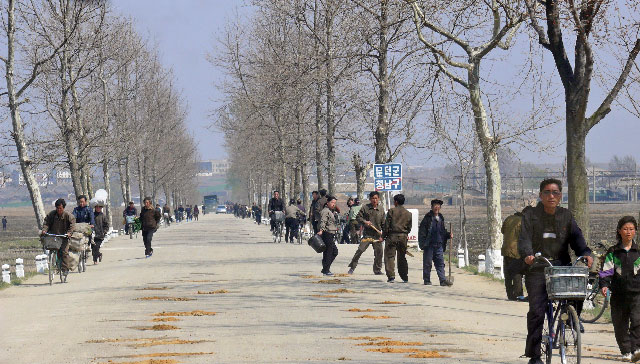
After a couple of days in Pyongyang, meeting officials, finalising plans and sightseeing, we drove 80 km north to the town of Anju, which would be our base for the next five days. Anju lies about 25km east of Mundok but had suitable hotel accommodation for the group. Our party consisted of the three from Miranda, two directors of the KEF, two biologists and the driver of the 10 seater minibus that we travelled everywhere in. This was an ideal vehicle for the country roads and tracks we needed to travel.
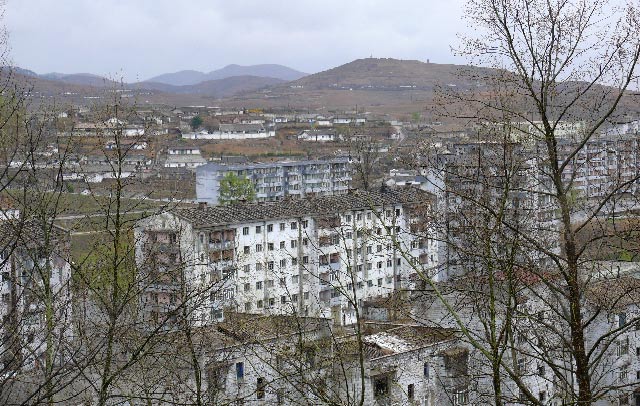
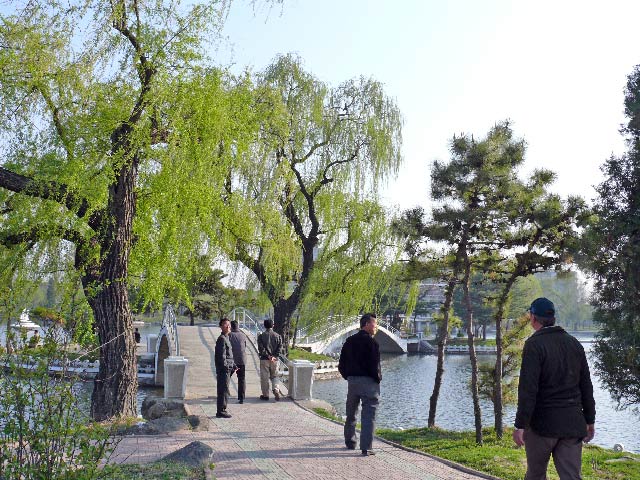

We spent three full days in the reserve counting shorebirds at high tide roosts, looking for leg-flagged birds from other countries and meeting nature reserve staff and their families. The first day was quite formal as both sides got to know each other but by the third day we were joined by staff and their families on the coast looking at shorebirds through binoculars and telescopes and picnicing on the seawalls. They were particularly keen to see colour-banded and leg-flagged birds to see for themselves birds that linked them to other countries on the East Asian-Australasian Flyway. Everything went very well and we were able to survey the entire reserve for shorebirds and other waterbirds.
Although there is a large rural based human population close to and in the reserve and people are actively gathering a variety of foods from the coastal environment, the roosting birds were very approachable, a strong indication they are left undisturbed. North Korean security issues restrict the number of people allowed on the mudflats and surrounding coastal areas and there was also no sign of active coastal development so the shorebird habitat at Mundok appears to be secure, at least for the time being.
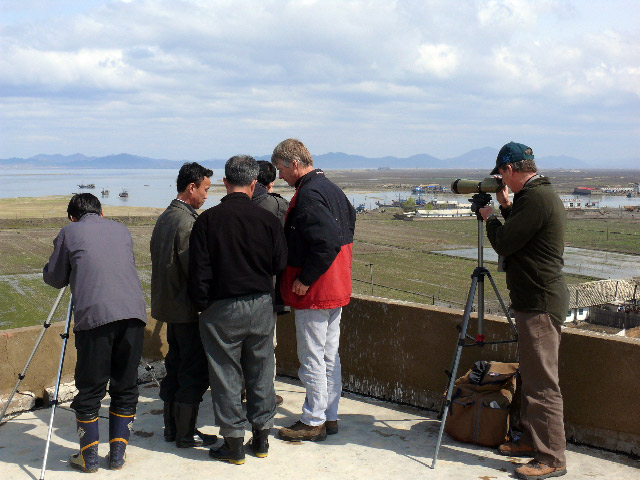
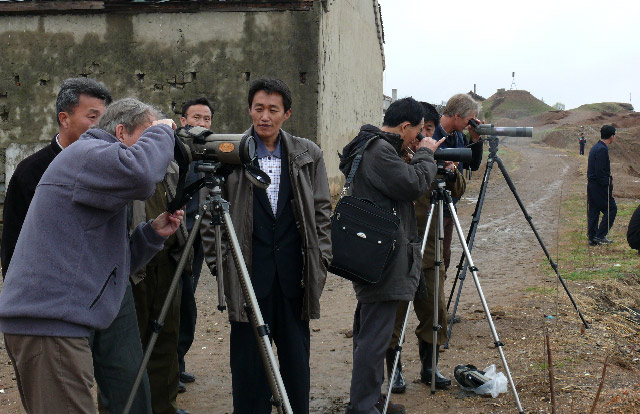
A total of 6,345 shorebirds of 22 species were counted at three roost sites within the reserve. Three shorebird species, Bar-tailed Godwit, Eurasian Curlew and Far-eastern Curlew occurred in internationally important numbers, (more than 1% of their respective populations) and the 82 Saunders’s Gulls counted represented 0.5% of the estimated 14,400 world population. At least 50 individual shorebirds from seven banding regions in four countries of the flyway were identified by their coloured leg bands and flags.
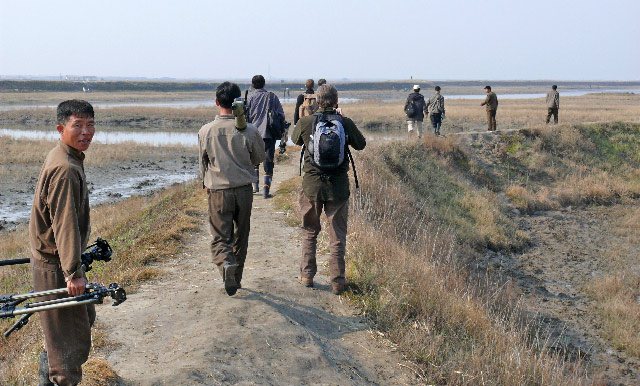
The mud at each site appeared to be very soft particularly along the main Chong Chon River, which probably accounts for why some species like Great Knot where in low numbers and Red Knot were absent, as their preferred food, small bivalves, are not abundant in soft mud. The ‘missing’ Great Knots from Saemangeum in South Korea where certainly not at Mundok.
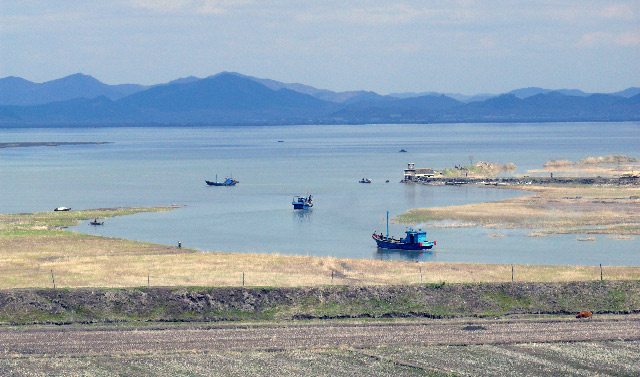
At the southern end of the reserve a series of small salt extraction ponds made an ideal roost site and this is where all the colour-banded birds were seen.
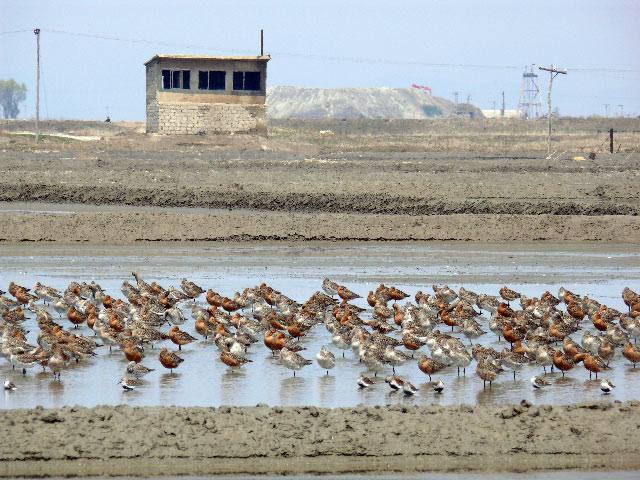

Figure 1. Map of DPRK and Mundok location
Total shorebird count for the Mundok Reserve 26-29 April 2009
| Species | Total | |
| Black-tailed Godwit | Limosa limosa | 3 |
| Bar-tailed Godwit | Limosa lapponica | 2,400 |
| Whimbrel | Numenius phaeopus | 49 |
| Eurasian Curlew | Numenius arquata | 630 |
| Far-Eastern Curlew | Numenius madagascariensis | 950 |
| Spotted Redshank | Tringa erythropus | 25 |
| Common Redshank | Tringa totanus | 24 |
| Common Greenshank | Tringa nebularia | 11 |
| Wood Sandpiper | Tringa glareola | 21 |
| Terek Sandpiper | Xenus cinereus | 149 |
| Common Sandpiper | Actitis hypoleucos | 3 |
| Great Knot | Calidris tenuirostris | 172 |
| Sanderling | Calidris alba | 2 |
| Red-necked Stint | Calidris ruficollis | 12 |
| Temminck's Stint | Calidris temminckii | 6 |
| Sharp-tailed Sandpiper | Calidris acuminata | 9 |
| Dunlin | Calidris alpina | 1,584 |
| Black-winged Stilt | Himantopus himantopus | 14 |
| Grey Plover | Pluvialis squatarola | 196 |
| Pacific Golden Plover | Pluvialis fulva | 40 |
| Kentish Plover | Charadrius alexandrinus | 11 |
| Lesser Sand Plover | Charadrius mongolus | 33 |
| Totals | 6,345 |
Bar-tailed Godwit
The baueri sub-species accounted for most of the Bar-tailed Godwit seen during the survey with much smaller numbers of the menzbieri sub-species present. This should change in early May, as menzbieri are known to migrate northward slightly later. Therefore, this count represents more than 1% of the estimated 155,000 baueri population.
Far-eastern Curlew
The count on 26 and 27 April represents approximately 2.5% of the estimated 38,000 world population.
Eurasian Curlew
The count on 26 and 27 April represents approximately 1.5% of the estimated 40,000 flyway population.
Approximately 50 individual birds were identified by flags and colour bands on their legs. These marked birds of five species were from seven regions of the flyway, South and North Islands New Zealand, Victoria, Southeast Queensland and North-western Australia, Chongming Dao, China and Barrow in Alaska.
Summary of engraved flags seen at Mundok 27–29 April 2009
| ENGRAVED FLAGS - BAR-TAILED GODWIT | ||||||||
| Flag Colour | Code | Banding Site | Banding Date | Age | Date Last Seen | Where Last Seen | Distance | |
| White | ARW | Miranda, New Zealand | 29.11.08 | 3+ | - | - | 9,893 km | |
| White | BSC | Miranda, New Zealand | 29.01.09 | 3+ | 01.03.09 | Miranda, NZ | 9,893 km | |
| White | APU | Miranda, New Zealand | 29.11.08 | 3+ | 29.03.09 | Miranda, NZ | 9,893 km | |
| Yellow | HP | Broome, NW Australia | 13.02.04 | ? | 27.08.06 | Broome, NW Australia | 6,355 km | |
| Green | DL | Brisbane, QLD, Australia | 21.03.08 | 2+ | 29.03.09 | Brisbane, QLD, Australia | 7,941 km | |
| ENGRAVED FLAGS - GREAT KNOT | ||||||||
| Yellow | EKU | Broome, NW Australia | 14.09.08 | 2 | - | - | 6,355 km | |
Summary of colour-banded birds seen at Mundok 27–29 April 2009
| COLOUR BANDED BAR-TAILED GODWITS from NEW ZEALAND | ||||||
| Colour Bands | Banding Site | Banding Date | Age | Date Last Seen | Where Last Seen | Distance |
| 5YBRY | Totara Ave, Golden Bay, SI | 03.02.07 | 3+ | 13.02.09 | Totara Ave, Golden Bay, SI | 10,072 km |
| 1BYBR | Warrington, Otago, SI | 28.02.06 | 3+ | 05.02.09 | Aramoana, Otago, NI | 10,445 km |
| 1BBWB | Awarua, Southland, SI | 26.10.04 | 3+ | 08.01.09 | Awarua Bay, Southland, SI | 10,431 km |
| 4YRRB | Foxton, Manawatu, NI | 18.02.07 | 3+ | 31.03.09 | Foxton, Manawatu, NI | 10,180 km |
| 1YBRB | Pakawau, Golden Bay, SI | 04.12.05 | 2? | 13.02.09 | Farewell Spit, S Island SI | 10,072 km |
| 2WWYR | Miranda, Firth of Thames, NI | 10.10.04 | 3? | 17.09.05 | Avon-Heathcote Est, Canterbury NI | 8,893 km |
| COLOUR BANDED DUNLIN from ALASKA, U.S.A | ||||||
| G flag /YL | Barrow, Alaska | June 2003 or 2004 | June 2007or 2008 at Barrow | 5,475 km | ||
Summary of flagged birds seen at Mundok 27–29 April 2009
| FLAGS ONLY | |||
| Species | Flag colours | Qty | Banding Region |
| Bar-tailed Godwit | White/Green | 1 | Nelson, South Island, NEW ZEALAND |
| Bar-tailed Godwit | White | 7 | Miranda, North Island, NEW ZEALAND |
| Bar-tailed Godwit | Orange | 5 | Victoria, AUSTRALIA |
| Bar-tailed Godwit | Green | 3 | Southeast Queensland, AUSTRALIA |
| Bar-tailed Godwit | Yellow | 5 | Broome, Northwest AUSTRALIA |
| Bar-tailed Godwit | White/Black | 1 | Chongming Dao, Shanghai, CHINA |
| Bar-tailed Godwit | Black/White | 3 | Chongming Dao, Shanghai, CHINA |
| Great Knot | Yellow | 4 | Broome, Northwest AUSTRALIA |
| Great Knot | Black/White | 1 | Chongming Dao, Shanghai, CHINA |
| Terek Sandpiper | Black/White | 1 | Chongming Dao, Shanghai, CHINA |
| Dunlin | Black/White | 1 | Chongming Dao, Shanghai, CHINA |
| Grey Plover | Black/White | 1 | Chongming Dao, Shanghai, CHINA |
Opportunistic waterbird counts at Mundok
| Waterbirds Species | Sites Totals | |
| Common Shelduck | Tadorna tadorna | 81 |
| Mallard | Anas platyrhynchos | 22 |
| Spot billed Duck | Anas zonorhyncha | 76 |
| Pintail | Anas acuta | 2 |
| Garganey | Anas querquedula | 12 |
| Common Teal | Anas crecca | 20 |
| Common Pochard | Aythya ferina | 5 |
| Little Grebe Tacybaptus | ruficollis | 18 |
| Great Crested Grebe | Podiceps cristatus | 2 |
| Black-crowned Night Heron | Nycticorax nycticorax | 20 |
| Grey Heron | Ardea cinerea | 7 |
| Great Egret | Casmerodius albus | 7 |
| Little Egret | Egretta gazetta | 1 |
| Coot | Fulica atra | 15 |
| Black-tailed Gull | Larus crassirostris | 4 |
| Vega Gull | Larus vegae | 31 |
| Black-headed Gull | Chroicocephalus brunnicephalus | 16 |
| Saunders's Gull | Saundersilarus saundersi | 82 |
| Caspian Tern | Hydroprogne caspia | 1 |
| Kingfisher | Alcedo atthis | 9 |
| Jack Snipe | Lymnocryptes minimus | 3 |
| The identification of these snipes is being reviewed | ||
| Totals | 434 | |
A species of particular interest to us is the Red Knot as it is the second most numerous arctic shorebird to visit New Zealand each year. The major staging sites in East Asia were largely unknown before 2009. Reasonable numbers have been recorded in the Bohai Sea but not enough it appeared, to account for the estimated flyway population of 220,000. News filtered in that large numbers of Red Knots had been found at sites in China’s Bohai Sea during May 2009. We await more details on these finds.
Mundok is an important staging site on the East Asian-Australasian Flyway for the baueri sub-species of Bar-tailed Godwit and both curlew species and is probably the final staging site for these birds before they depart for the breeding grounds. One of the workers at the salt ponds indicated that in 2008 perhaps three times as many shorebirds, (mostly Bar-tailed Godwit we think) were using the site. Whether this was in April or May is unclear but is worthy of further investigation.
With vitally important shorebird refuelling sites being lost to development around the West Sea, Mundok will become increasingly important for shorebirds in the future and surveying this and other suitable sites nearby on a regular basis would be extremely valuable.
Our time in North Korea was excellent, we were extremely well looked after by our hosts who where very knowledgeable on many wildlife subjects but admitted they knew almost nothing about shorebirds. They learnt a great deal in the short time we were with them and read everything we gave them relating to shorebirds on the flyway, including Jan van der Kam’s book, ‘Invisible Connection’.
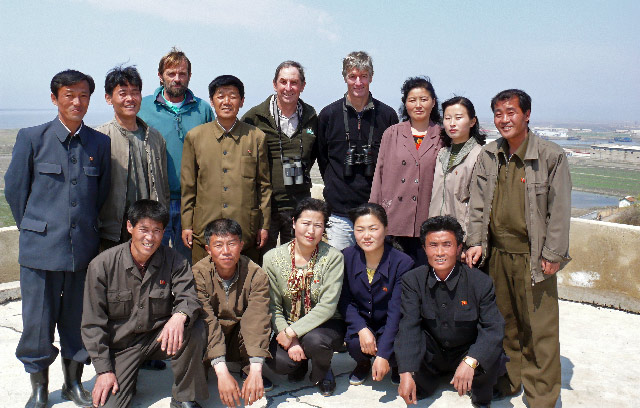
The rural scene at Mundok is one of intensively cultivated coastal plains consisting almost entirely of rice paddies, while the rolling hills inland were given over to vegetable and fruit production. The fields were being prepared for planting during our visit with most of the work being done manually by hundreds of people who walked and bicycled everywhere, much as we have seen in areas around Yalu Jiang in China, although more machines are used there. Almost every square metre of land is cultivated, leaving very little room for any natural habitat or wildlife. As it was still quite early in the spring, what trees there were, had just started breaking into leaf.
Whilst we were not free to explore anywhere on our own, be it the streets of Pyongyang or the hotel gardens at Anju, which had a good selection of trees that were a haven for migrating passerines, one or more of our Korean party were always willing to walk with us and were keen to identify any birds we saw.
May 1st is a national holiday in North Korea and we spent the day in Pyongyang with Mrs Kim the Vice-Director of KEF and another of our hosts, Mr Ri Thae Gun, visiting some of the famous attractions in the city but particularly Moran Hill in the centre of the city. This forest-covered hill with many small gardens and numerous walking tracks is a popular place for thousands of local people who were enjoying walking, picnicing or the May Day dance festivals. Many women were in traditional Korean dress for the day.

Without the initial request from the former New Zealand Foreign Affairs Minister the Rt Hon Winston Peters the survey would not have taken place and we are very grateful to him. This survey would also not have been possible without the considerable help of the DPRK/NZ Friendship Society, in particular Mrs Ji Yon Ok in North Korea. Don Borrie and Peter Wilson in New Zealand also assisted greatly with the initial planning. The Korean Natural Environment Conservation Fund arranged all internal travel and other logistical support and we are indebted to them for making it all possible. Sin Hyok Chol, Choe Il Chol and all the Mundok Reserve staff and their families made us very welcome and were a pleasure to work with. Kim Kwang Pil and Pak Ung, two scientists who helped with the survey had extensive knowledge of natural sciences and were very valuable members of the group. We must also acknowledge the considerable logistical and financial support of the New Zealand Ministry of Foreign Affairs and Trade. The New Zealand Department of Conservation and the Lottery Minister’s Discretionary Fund also assisted with funding.
Before leaving North Korea a cooperation agreement was signed between the KEF and MNT to help facilitate further joint studies and it is hoped that members of the MNT can return to North Korea in early May 2010 to continue surveying parts of the coast for shorebirds. It is also hoped a KEF delegation from North Korea can visit New Zealand later this year or early in 2010.
Birds Korea 1108 Ho, 3 Dong, Samick Tower Apt., 148-22, Namcheon-Dong, Su-Young-Gu
Busan, 618-762 Republic of Korea



